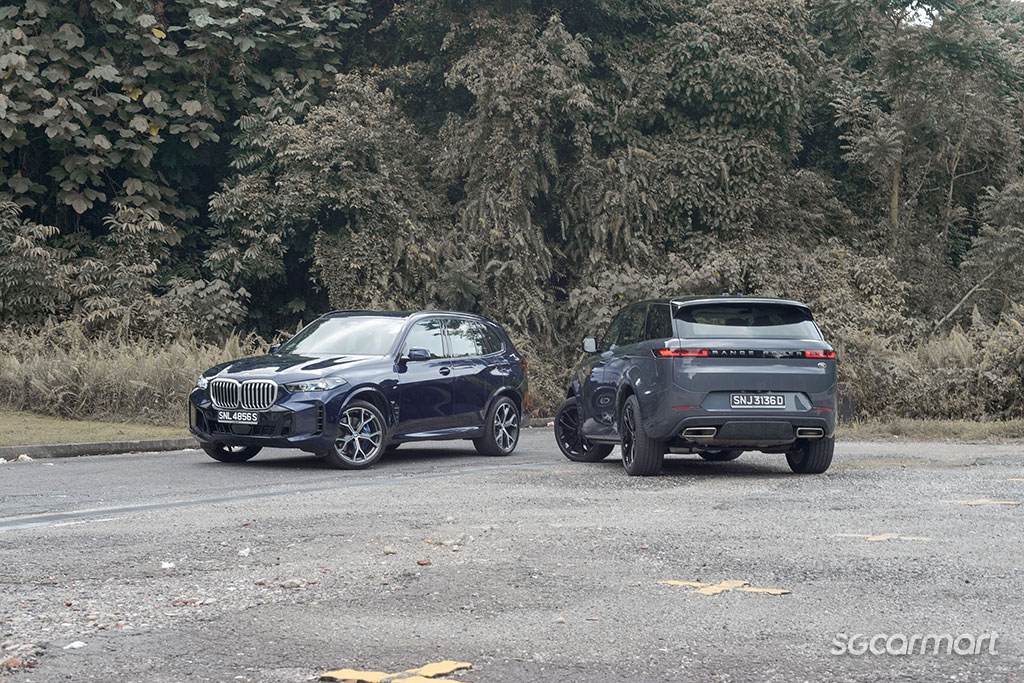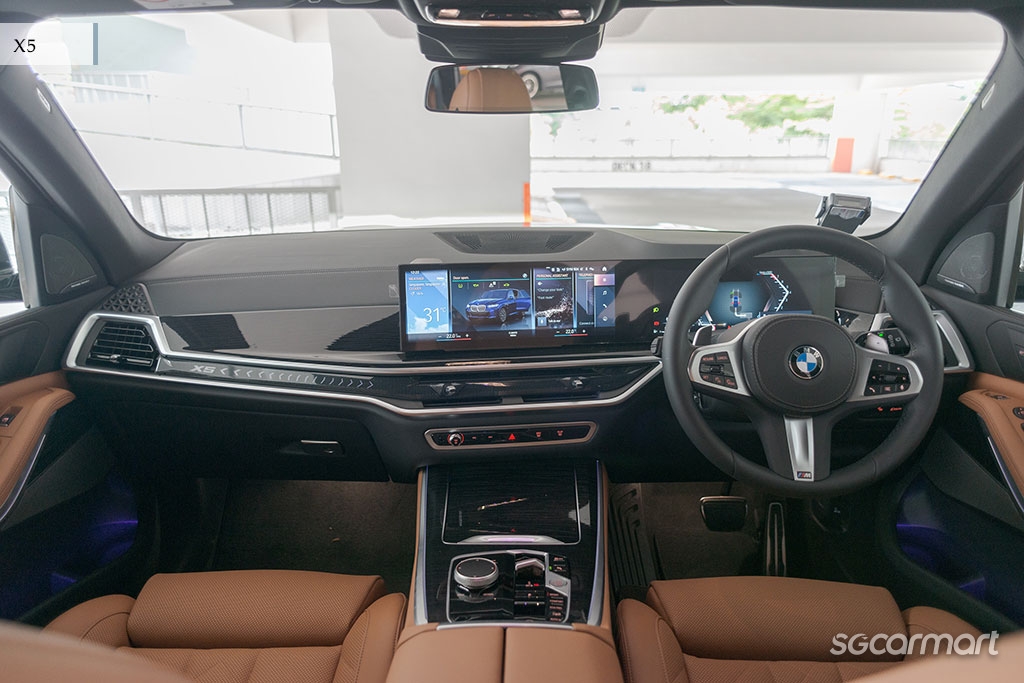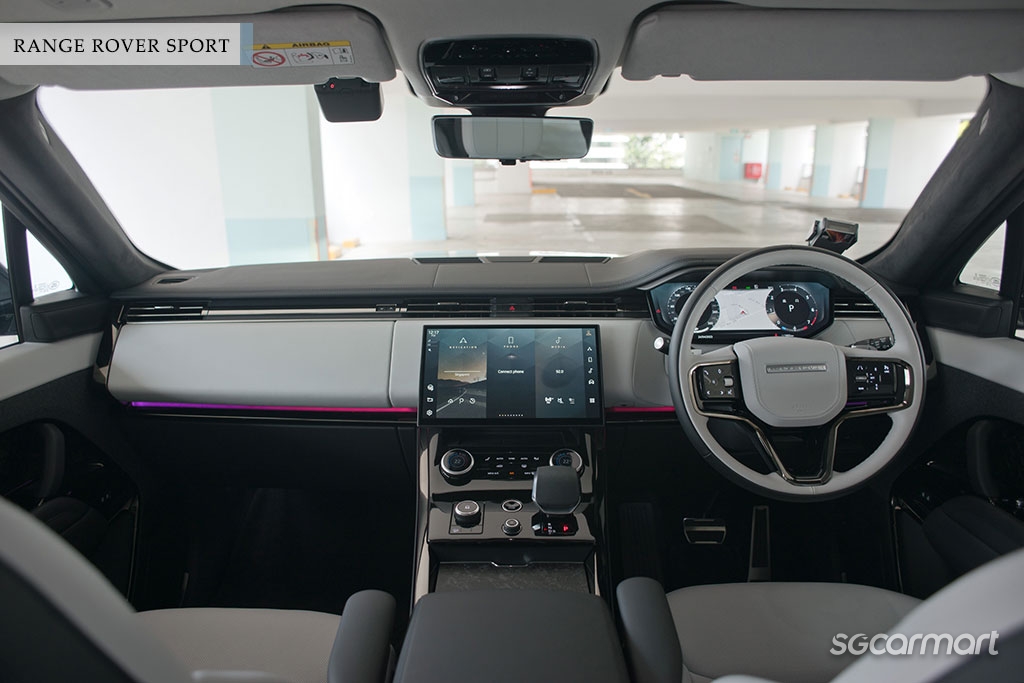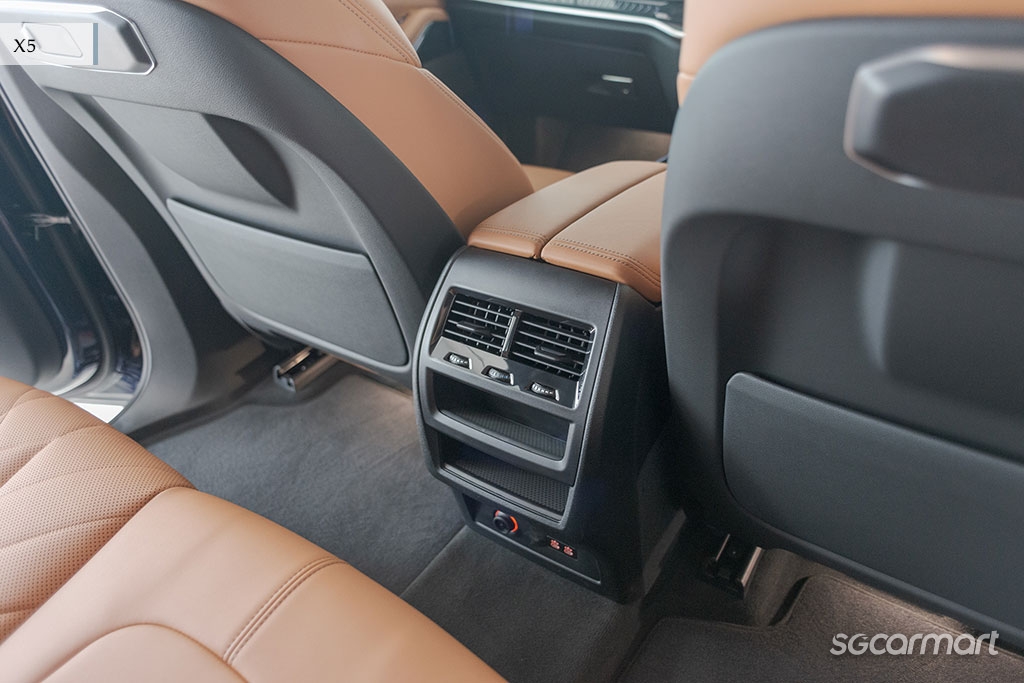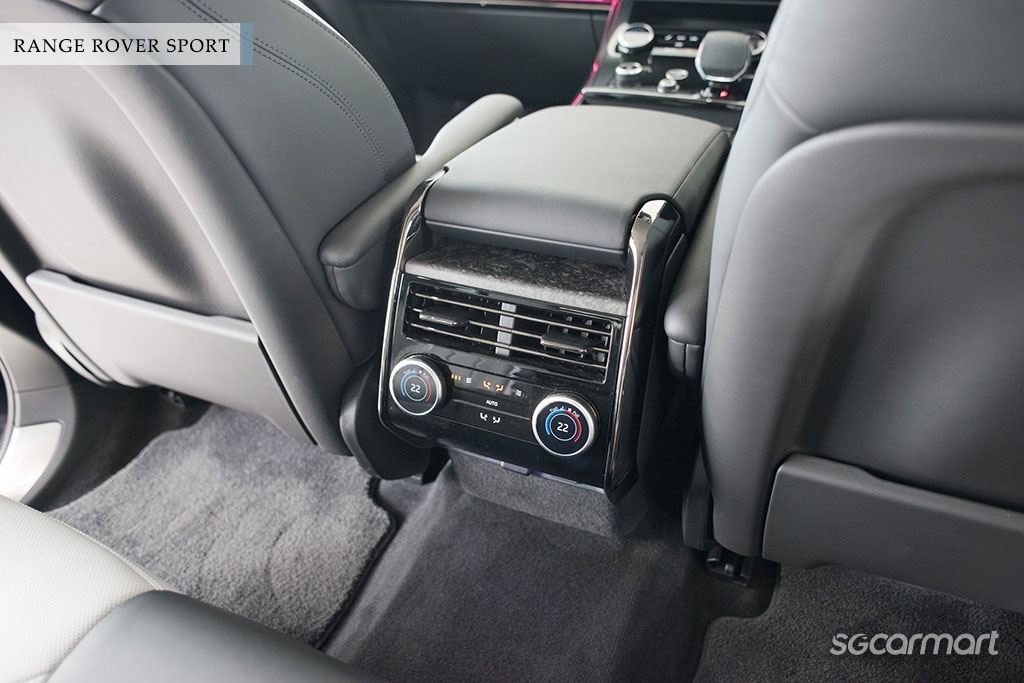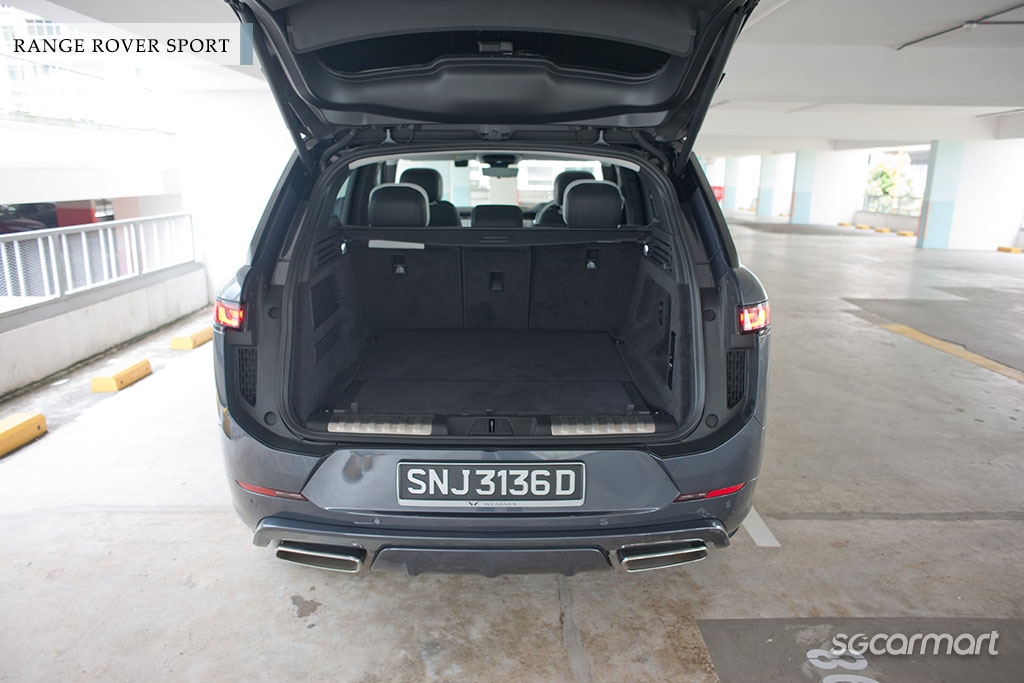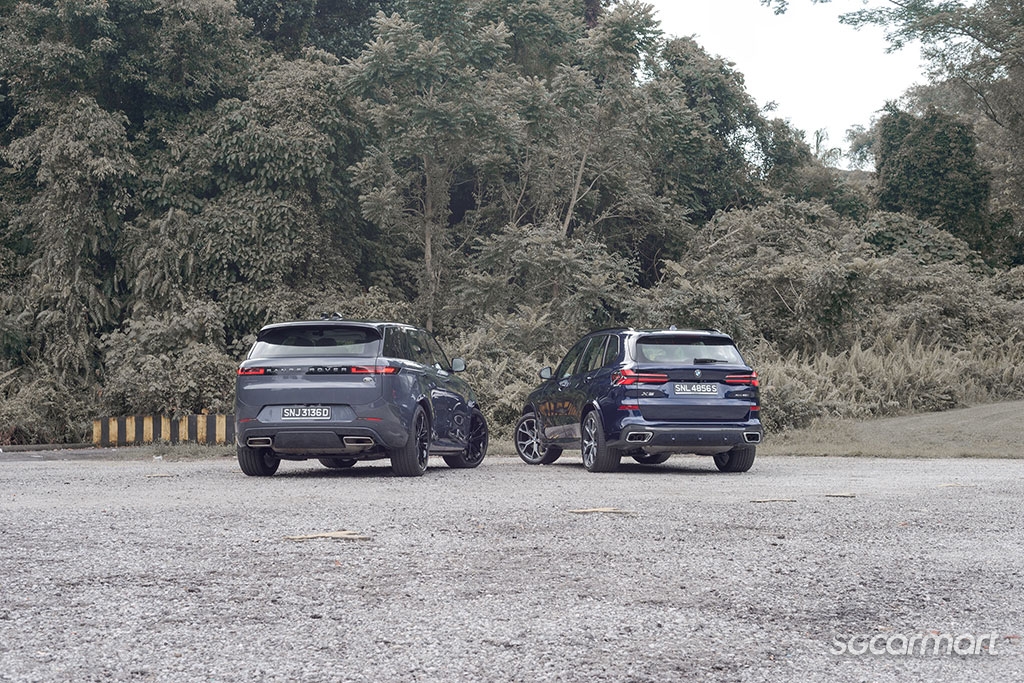BMW X5 xDrive40i vs Range Rover Sport 3.0
20 Nov 2023|15,859 views
Range Rover Sport
More imposing exterior design
Plusher material use in the cabin
More comfortable and quieter ride
BMW X5
Easier to pilot through tight spaces
More engaging to drive
Available at a lower price
In a world where most of the products we consume are becoming increasingly similar thanks to mass production, driving these two back-to-back has been a bit of a revelation.
The two cars look nearly identical on paper: Both measure in at close to five meters in length, deliver close to 400bhp from their 3.0-litre engines, come with all-wheel drive, and offer electrification in the form of mild hybrid assistance.
But just one afternoon behind the wheel of the two has revealed them both to be completely different machines.
Angular and sporty, or strong and stately?
Let's start off with the exteriors of both cars. Finished in Tanzanite Blue Metallic, the BMW X5 is decked full of curving lines and angles, allowing it to hide its sheer mass by offering some new line or angle everywhere you care to look. It's decidedly sporty as well, with its sizeable front grille, side skirts, and vents aft of the front wheels. And at the back, those redesigned taillights now take on an X-shape - all the better for model recognition, if a little kitsch a design touch.
The Range Rover Sport, in contrast, shuns such embellishments. Its visually defining elements, such as the head and taillights as well as its front grille, all feature less prominently on the body of the car, allowing its strong front and slab-sidedness to define your overall impression of the car. Park and lock the Range Rover Sport up and the door handles and those side steps fold neatly into the vehicle - so it always looks as stately as possible.
The Range Rover Sport just manages to beat the BMW X5 for overall ease of use, thanks to its use of physical air-conditioning controls
Step within either car and you'll see the same design philosophy mirrored in their cabins. The BMW X5 offers a wide variety of angles and materials on its dashboard, and the Operating System 8 housed within that sizeable curved display impresses and intimidates in equal measure with the sheer number of icons available within its menus.
The perceived levels of luxury in the Range Rover Sport, meanwhile, is aided greatly by this example's use of white leather in the cabin, which draw the eye to its clean dashboard design as well as those slim air-conditioning vents - all of which exude a minimalism and look like they could have been the product of Mies van der Rohe's own pen.
The BMW X5 comes with a two-zone climate control system, while a four-zone climate control system is available on the both the 'Dynamic SE' and 'Dynamic HSE' trims of the Range Rover Sport as part of the $17,790 Hot Climate Pack
Land Rover's Pivi Pro system (here housed within a 13.1-inch infotainment screen) is arguably more welcoming next to the BMW's - displaying less outright information on its home screen while offering larger icons within its main menu.
The Range Rover Sport also gets roundels on the centre console that allow quick access to the air-conditioning controls - access to these is only available via the touchscreen in the BMW. And the cushioning on offer from the seat bases and headrests are noticeably softer in the Range Rover Sport than those in the BMW X5.
Keen and eager, or planted and comfortable?
Thumb the engine start buttons of either car and shift them into gear, and it's now the Range Rover Sport's turn to intimidate. It may be mere centimetres wider and longer than the BMW X5, but from the driver's seat, the beltline of the Range Rover Sport seems to rise around you much more so than in the X5, making it the more difficult car from which to judge just how much space there is at the corners.
Leave the tight confines of a multi-storey for the open road and the Range Rover Sport will feel more at home. Left in its 'Comfort' mode, the steering of the Range Rover Sport delivers good weightiness while the pedals both offer a finely judged level of resistance, both fitting for a car that is essentially 2,385kg worth of steel, aluminium, and leather. The cabin of the Range Rover Sport also feels the quieter of the two cars here.
The Range Rover sport comes with 835 litres of space at the rear, while the BMW X5 offers a total of 650 litres of boot space but comes with a split tailgate
Body control, however, is not as great in the Range Rover Sport - the car permits more than a fair amount of vertical movement when you're taking on undulating roads.
If it's confidence while making rapid progress you're after from your SUV, the BMW X5 should be a better fit. Next to the Range Rover Sport, the BMW X5 feels the more brittle car over poor roads. You'll feel the ruts on the road in the X5 that the Range Rover Sport simply hides - both via your bum and the steering wheel - but the X5 counters with better body control. And the BMW also exhibits a greater eagerness to turn and greater throttle response, factors that matter to the eager driver.
If money were no issue, deciding between the two gathered here is an easy process. The Range Rover Sport offers greater comfort and comes with a decidedly more luxurious cabin, while the BMW X5 is the SUV to get if you're after a car that can truly make rapid progress over a twisting stretch of road.
But those who will feel the pinch from putting aside half-a-million for a car will also need to consider the fact that the BMW X5 starts from $516,888, while the Range Rover Sport in 'SE' trim (the car that appears here is a 'First Edition' model that is no longer available to order here in Singapore), comes in at $486,888, even before COE (all prices as of 15 November 2023).
At that price difference, I'd say the staff back at BMW Spartanburg are doing a better job at mass producing the X5.
Looking for more comparisons? These stories may interest you
Mercedes-Benz GLC300 faces off against the BMW X3 xDrive30i
BMW 520i takes on the Lexus ES300h
Volvo XC60 B5 R-Design goes up against the Jaguar F-PACE 2.0
Range Rover Sport
More imposing exterior design
Plusher material use in the cabin
More comfortable and quieter ride
BMW X5
Easier to pilot through tight spaces
More engaging to drive
Available at a lower price
In a world where most of the products we consume are becoming increasingly similar thanks to mass production, driving these two back-to-back has been a bit of a revelation.
The two cars look nearly identical on paper: Both measure in at close to five meters in length, deliver close to 400bhp from their 3.0-litre engines, come with all-wheel drive, and offer electrification in the form of mild hybrid assistance.
But just one afternoon behind the wheel of the two has revealed them both to be completely different machines.
Angular and sporty, or strong and stately?
Let's start off with the exteriors of both cars. Finished in Tanzanite Blue Metallic, the BMW X5 is decked full of curving lines and angles, allowing it to hide its sheer mass by offering some new line or angle everywhere you care to look. It's decidedly sporty as well, with its sizeable front grille, side skirts, and vents aft of the front wheels. And at the back, those redesigned taillights now take on an X-shape - all the better for model recognition, if a little kitsch a design touch.
The Range Rover Sport, in contrast, shuns such embellishments. Its visually defining elements, such as the head and taillights as well as its front grille, all feature less prominently on the body of the car, allowing its strong front and slab-sidedness to define your overall impression of the car. Park and lock the Range Rover Sport up and the door handles and those side steps fold neatly into the vehicle - so it always looks as stately as possible.
The Range Rover Sport just manages to beat the BMW X5 for overall ease of use, thanks to its use of physical air-conditioning controls
Step within either car and you'll see the same design philosophy mirrored in their cabins. The BMW X5 offers a wide variety of angles and materials on its dashboard, and the Operating System 8 housed within that sizeable curved display impresses and intimidates in equal measure with the sheer number of icons available within its menus.
The perceived levels of luxury in the Range Rover Sport, meanwhile, is aided greatly by this example's use of white leather in the cabin, which draw the eye to its clean dashboard design as well as those slim air-conditioning vents - all of which exude a minimalism and look like they could have been the product of Mies van der Rohe's own pen.
The BMW X5 comes with a two-zone climate control system, while a four-zone climate control system is available on the both the 'Dynamic SE' and 'Dynamic HSE' trims of the Range Rover Sport as part of the $17,790 Hot Climate Pack
Land Rover's Pivi Pro system (here housed within a 13.1-inch infotainment screen) is arguably more welcoming next to the BMW's - displaying less outright information on its home screen while offering larger icons within its main menu.
The Range Rover Sport also gets roundels on the centre console that allow quick access to the air-conditioning controls - access to these is only available via the touchscreen in the BMW. And the cushioning on offer from the seat bases and headrests are noticeably softer in the Range Rover Sport than those in the BMW X5.
Keen and eager, or planted and comfortable?
Thumb the engine start buttons of either car and shift them into gear, and it's now the Range Rover Sport's turn to intimidate. It may be mere centimetres wider and longer than the BMW X5, but from the driver's seat, the beltline of the Range Rover Sport seems to rise around you much more so than in the X5, making it the more difficult car from which to judge just how much space there is at the corners.
Leave the tight confines of a multi-storey for the open road and the Range Rover Sport will feel more at home. Left in its 'Comfort' mode, the steering of the Range Rover Sport delivers good weightiness while the pedals both offer a finely judged level of resistance, both fitting for a car that is essentially 2,385kg worth of steel, aluminium, and leather. The cabin of the Range Rover Sport also feels the quieter of the two cars here.
The Range Rover sport comes with 835 litres of space at the rear, while the BMW X5 offers a total of 650 litres of boot space but comes with a split tailgate
Body control, however, is not as great in the Range Rover Sport - the car permits more than a fair amount of vertical movement when you're taking on undulating roads.
If it's confidence while making rapid progress you're after from your SUV, the BMW X5 should be a better fit. Next to the Range Rover Sport, the BMW X5 feels the more brittle car over poor roads. You'll feel the ruts on the road in the X5 that the Range Rover Sport simply hides - both via your bum and the steering wheel - but the X5 counters with better body control. And the BMW also exhibits a greater eagerness to turn and greater throttle response, factors that matter to the eager driver.
If money were no issue, deciding between the two gathered here is an easy process. The Range Rover Sport offers greater comfort and comes with a decidedly more luxurious cabin, while the BMW X5 is the SUV to get if you're after a car that can truly make rapid progress over a twisting stretch of road.
But those who will feel the pinch from putting aside half-a-million for a car will also need to consider the fact that the BMW X5 starts from $516,888, while the Range Rover Sport in 'SE' trim (the car that appears here is a 'First Edition' model that is no longer available to order here in Singapore), comes in at $486,888, even before COE (all prices as of 15 November 2023).
At that price difference, I'd say the staff back at BMW Spartanburg are doing a better job at mass producing the X5.
Looking for more comparisons? These stories may interest you
Mercedes-Benz GLC300 faces off against the BMW X3 xDrive30i
BMW 520i takes on the Lexus ES300h
Volvo XC60 B5 R-Design goes up against the Jaguar F-PACE 2.0
Car Information
BMW X5 Mild Hybrid xDrive40i M Sport (A)
$490,888
CAT B|Petrol-Electric|10.8km/L
Horsepower
280kW (375 bhp)
Torque
550 Nm
Acceleration
5.5sec (0-100km /hr)
Promotion
Stand to win $45,000, enjoy an additional 5-year road tax, and more only with BMW JoyFest-PML45 Edition.
Read moreLand Rover Range Rover Sport Mild Hybrid
CAT B|Petrol-Electric|9.8km/L
Horsepower
294kW (394 bhp)
Torque
550 Nm
Acceleration
5.7sec (0-100km /hr)
Thank You For Your Subscription.
- Different Styles
- Different Experiences
- Different Drives
- Which To Get




















































